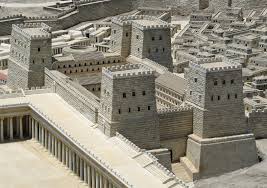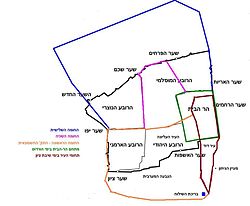How many locks? Guest blog: Eli Duker!
Eruvin 101
How many keys-locks-walls??
By Eli Duker, guest blogger and guide
How many keys-locks-walls??
By Eli Duker, guest blogger and guide
 |
| Model of Antonia Fortress, where the second wall began |
The Mishna brings a dispute between Rabbi Meir on one hand, and the Sages and Rabbi Yose on the other, regarding the permissibility of unlocking a door when one is in a different reshut than the door. Rabbi Meir forbids it, and the Sages permit it based on their claim that in people were lenient on the matter in the שוק של פטמים in Second Temple-era Jerusalem.
Rabbi Yose claims, however, that the Shuk in question was the Wool market. At first glance it seems strange that he would take issue over a seemingly irrelevant detail.
The Gemara questions the relevancy of the Jerusalem key precendent. It cites Rabbi Yochanan, that as Jerusalem was a walled city whose gates closed at night, its status cannot be that of a “Public Domain” – רשות הרבים. Hence there is reason to be lenient in Jerusalem; how can the Shuk practice be considered to be relevant across the board?
The first answer the Gemara gives is that of Rav Pappa. He answered that Jerusalem’s lenient status was only relevant before there were breaks (in the walls); later there were openings in the walls which nullified their status as מחיצות, giving Jerusalem the strigent רשות הרבים status.
In order to understand Rav Pappa’s statement, we turn to Josephus who writes that by the time of the Great Revolt, there were three walls around Jerusalem, as seen in this map.
 |
| Dr. Eyal Meron’s map of Jerusalem fortifications at the end of the Second Temple period |
The first wall (in beige), built in the 2nd century BCE by the Hasmoneans, was by and large along the same lines as that built by Hezekiah in the First Temple era. Josephus[1]doesn’t tell us when the second wall (in purple) was built. One can conjecture that is was built in the first century BCE, by either the Hasmoneans or Herod, due to the city’s expansion to the north. The third wall (in black) was built in the 1st century CE. Josephus describes how Agrippa began construction in the 40s CE of a third wall as the city’s population had grown until people had to live outside of the fortified city, creating the suburb of Bet Zaida, which then needed to be fortified. He stopped building when Emperor Claudius, afraid that such a wall would make the city unconquerable, made him stop. It was then finished in the early stages of the Great Revolt.
Hence Rav Pappa is aware of the fact that the city, in different stages, went from being totally enclosed by walls to having unwalled sections. The city (at least in part) was a Reshut Harabim from 40-66, and in all likelihood, before and during the construction of the second wall.
Now back to the markets… The Sages claim that the door openings took place in the שוק של פטמים which is understood by most commentators to be a market for fattened meat or fowl[2]. Rabbi Yose, however, claims that this was the practice in the wool market.
Josephus[3] actually mentions that the wool market was on the inside of the second wall, along with a few other markets, none of which could possibly be the שוק של פטמים. Hence, one can argue that allowing one to unlock a door with a key on Shabbat in the “New City” – where the wool market was- was a bigger leniency (for a certain time period) than doing the same in a market that, in all likelihood, was within the walls from the beginning of the Hasmonean period.
Wars V 136-154
[2] Rashi , Rif
[3] Wars VI 331



Comments
Post a Comment